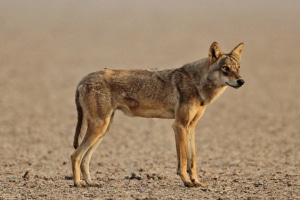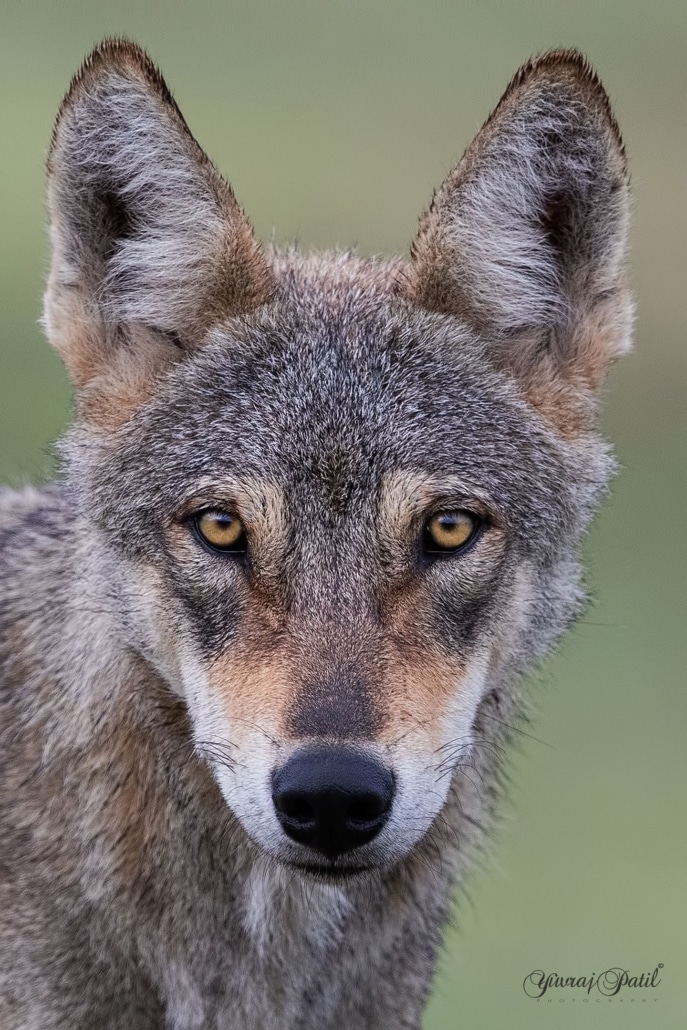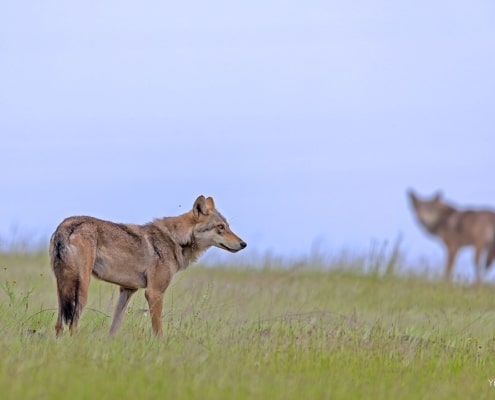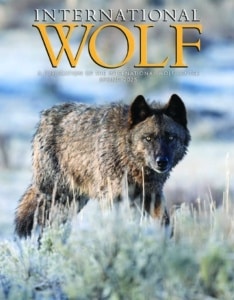Commentary by DR. Yadvendradev V Jhala
Carnivores by their very definition need to prey upon other creatures to survive. Humans, though not armed with formidable teeth and claws, are the top predator due to our intellect, use of tools and cohesive social hunting strategies.
Most large carnivores have learned to stay clear of this top predator over millennia, but some exceptions exist. Recently, a spate of attacks, mostly on children and old frail adults attributed to wolves in Bahraich county of Uttar Pradesh, India, has brought the Indian wolf into focus and controversy.
 Between March and September in 2024 attack reports included 10 human fatalities and 30 injuries. Four wolves were captured, one wolf was shot, and some feral dogs were killed in the region, which resulted in the cessation of attacks. Indian and international media went berserk with wild stories, interviewing anyone with an opinion, even attributing the attacks to climate change and revenge killing by the wolf pack.
Between March and September in 2024 attack reports included 10 human fatalities and 30 injuries. Four wolves were captured, one wolf was shot, and some feral dogs were killed in the region, which resulted in the cessation of attacks. Indian and international media went berserk with wild stories, interviewing anyone with an opinion, even attributing the attacks to climate change and revenge killing by the wolf pack.
Before this incident, few people were aware that wolves even exist in India. Despite Rudyard Kipling’s Jungle Book, Sherkhan, the tiger, and his types have overshadowed knowledge of Akehla and his pack. Yet, the Indian wolf is an original denizen of India, having evolved a million years ago within the sub-continent, being the oldest extant lineage of wolves in the world. Tigers, lions and humans arrived in India more recently, the former from the east and the latter two from the west.
The Indian wolf is a small (about 44-pound) and fast predator of open landscapes, hunting blackbuck antelope, gazelle, hare and young nilgai antelope. Most of the open landscapes of India are now farmlands or pasture for livestock to cater to the food needs of about 1.4 billion people. Long gone are the antelope and gazelle. This puts wolves in direct conflict with human interests, since they are left with little alternative other than to prey on small livestock and scavenge cattle carcasses.
 Wolves in India number between 2,000 and 3,000 and are more endangered than the tiger. As per Indian wildlife legislation, wolves have the same status as the tigers and the Asiatic lions. The minimum punishment for a convicted wolf poacher is three years, extendable to seven years. Yet, unlike for the tiger and the lion, no wolf poacher has been convicted. No specific policy guidelines or conservation investments exist for the Indian wolf. Wolf pups continue to be killed in their dens even before their eyes open; packs are poisoned across their range; and road kills on modern high-speed roadways–mostly without any wildlife overpasses–across the wolf’s range all take their toll.
Wolves in India number between 2,000 and 3,000 and are more endangered than the tiger. As per Indian wildlife legislation, wolves have the same status as the tigers and the Asiatic lions. The minimum punishment for a convicted wolf poacher is three years, extendable to seven years. Yet, unlike for the tiger and the lion, no wolf poacher has been convicted. No specific policy guidelines or conservation investments exist for the Indian wolf. Wolf pups continue to be killed in their dens even before their eyes open; packs are poisoned across their range; and road kills on modern high-speed roadways–mostly without any wildlife overpasses–across the wolf’s range all take their toll.
Wolves are losing ground in India rapidly. With a decreasing number of wolves and an increasing number of feral dogs (about 66 million), wolves and dogs interbreed, creating hybrids that threaten to swamp the wild wolf gene pool. Indian wolves, like all wolves, are shy and try to avoid contact with the apex predator – humans. But, with very high human density (1,264 people per square mile, compared to 95 in the United States) and with livestock as their primary food, wolves have little choice but to come in contact with people. This familiarity with humans by wolves and wolf-dog hybrids attenuates their fear of people, however sometimes under very specific conditions, a clever canid learns that children are an easier prey compared to livestock.
Yet, attacks on humans by the small Indian wolves are extremely rare compared to other wildlife. Over 50 people are killed annually by tigers, over a 100 each to wild boar and leopards, over 50,000 to snake bites and 250,000 to road accidents. Meanwhile, in the past 30 years, wolves have been responsible for a very few proven incidences of attacks. These attacks of wolves on humans have only been reported from the states of Bihar, Uttar Pradesh and Madhya Pradesh.
On investigating the conditions under which these attacks occurred, some commonalities emerge with the recent attacks in Bairaich: 1) There is little or no wild prey, as all antelope, deer and hare have long been consumed by people; 2) People live in dire poverty , especially the victims’ families. They have poor, or no, housing, poor lighting at night, and adults are often absent, so unable to care for the children. Small children are left in the care of elder children while the parents or single mothers work away from home. Toilets are rare or even rarely used, with defecation in the open being the norm. 3) Livestock are heavily guarded to deter predators, as they are prized possessions.
Under such unique circumstances, all it takes for a predator to survive is to learn that children and old, frail adults are easy options. We humans do not feel vulnerable. Yet by predators we can sometimes be viewed as a source of food, usually a very dangerous source of food. But when the only other choice is death by starvation a predator sometimes overcomes its inherent fear of humans.
 During my research on Indian wolves for the past 30 years, I have approached wolves, their dens and rendezvous sites on foot and horseback and captured their pups from dens to weigh them, while the pack stood and watched some 55 to 65 yards away. During such times I have never felt threatened or in any danger in the presence of wolves. From my perspective, it is only under certain unique conditions that wolves consider humans as prey. Most attacks by wolves on people occur when wolves are rabid, mistake humans as prey, or have become very familiar with people.
During my research on Indian wolves for the past 30 years, I have approached wolves, their dens and rendezvous sites on foot and horseback and captured their pups from dens to weigh them, while the pack stood and watched some 55 to 65 yards away. During such times I have never felt threatened or in any danger in the presence of wolves. From my perspective, it is only under certain unique conditions that wolves consider humans as prey. Most attacks by wolves on people occur when wolves are rabid, mistake humans as prey, or have become very familiar with people.
Until recent times, deaths caused by predators were an accepted form of mortality, just like we look upon deaths by road accidents today. However, as human societies removed all predators from their neighborhoods, our memory and acceptance of this historical cause of human mortality faded. So now, when a tiger becomes a man eater or a wolf a child lifter, the paradigm has changed, and the media grabs this as an opportunity to exaggerate and sensationalize the ingrained notion of the “Big Bad Wolf.”
Loss of human lives is unacceptable to society, and animals that are a threat are wiped out over time. The West has witnessed extinction of its carnivores, which are now making a gradual comeback through reintroductions and more tolerance, which usually comes with prosperity. Indian society is arguably the most tolerant towards other life forms, even large carnivores. This tolerance primarily emanates from the religious teachings of Hinduism, Jainism and Buddhism, which consider humans as custodians of nature. Today, in an economy- and value-driven society, these traditional tolerances are often tested to the limit.
The backlash from society, fueled by sensational reporting, is not limited to the problem animal but to the entire population, and sometimes to the entire species as well. Human lives take precedence over those of animals, and wildlife managers are called on to act swiftly to remove the problem animal. Delay in such actions has dire consequences for the continued survival of the species among human dominated landscapes.
However, since society now has low tolerance for mortality by wild animals, and in particular by wolves, we have to address the root causes. In this landscape they are poverty and lifestyles. Proper housing, childcare and improving lifestyles will address this conflict permanently. Wild animals such as wolves need space and resources to survive in this home on the planet we share with them. However, we have hogged all the space and resources for ourselves, pushing wolves and other wildlife to the brink of extinction. They are only fighting for their survival. If you see it from their perspective, we are the villains who are responsible for their genocide.
 This article was originally published in the Spring 2025 edition of International Wolf magazine, which is published quarterly by the International Wolf Center. The magazine is mailed exclusively to members of the Center.
This article was originally published in the Spring 2025 edition of International Wolf magazine, which is published quarterly by the International Wolf Center. The magazine is mailed exclusively to members of the Center.
To learn more about membership, click here.
About the author: Dr. Jhala is a Senior Scientist of Indian National Science Academy at the National Centre of Biological Sciences.

The International Wolf Center uses science-based education to teach and inspire the world about wolves, their ecology, and the wolf-human relationship.
